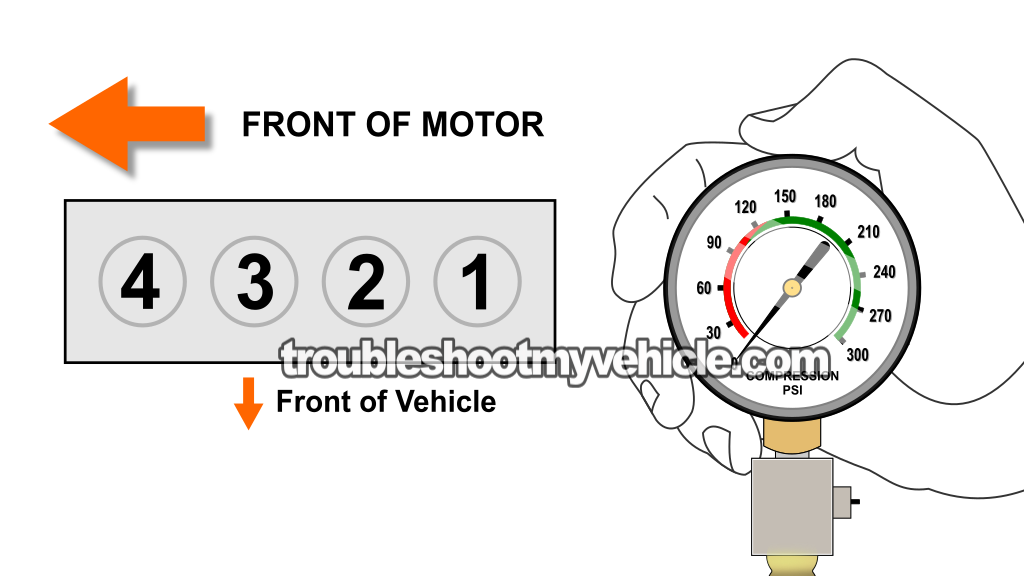
The engine compression test is one of the best ways to find out the internal health condition of your 1.5L Honda Civic's engine. In this tutorial I'll explain how to do a dry and wet engine compression test.
The dry compression test let's us know what cylinders (if any) have compression issues. The wet compression test will pinpoint the cylinder compression problem to either worn cylinder head valves or worn piston rings.
Contents of this tutorial:
ES ![]() You can find this tutorial in Spanish here: Cómo Probar La Compresión Del Motor (1.5L Honda Civic) (at: autotecnico-online.com).
You can find this tutorial in Spanish here: Cómo Probar La Compresión Del Motor (1.5L Honda Civic) (at: autotecnico-online.com).
APPLIES TO: This tutorial applies to the following vehicles:
- 1.5L Honda Civic: 1992, 1993, 1994, 1995.
- 1.5L Honda Civic Del Sol: 1993, 1994, 1995.
CYLINDER MISFIRE DIAGNOSTICS:
ENGINE NO-START DIAGNOSTICS:
Symptoms Of Low Or No Engine Compression
Engine compression problems usually cause one of two things: a rough idle/misfire condition or a cranks but does not start condition.
Having low or no engine compression in one cylinder on your 1.5L Honda will cause your engine to miss at idle and you'll definitely feel there's something wrong when you accelerate the vehicle.
Having 0 compression on two ADJACENT engine cylinders or on all cylinders and your 1.5L Honda won't start. It'll crank but not start. This usually indicates that the head gasket has burned between the two cylinders.
When you have a situation where you have no compression on 2 or ALL 4 cylinders, you'll see:
- The engine cranks very fast and this fast cranking speed is very noticeable.
- The ignition system is sparking all 4 spark plugs, so you know it's not an ignition system problem/issue.
- The fuel injectors spray fuel.
- You can confirm this with a Noid Light test.
- Also, you can confirm this, although indirectly, by removing the spark plugs and checking to see if they are fuel soaked (fuel fouled).
- Fuel pump is working and providing pressure.
- The most common causes of this scenario, are:
- Blown head gasket.
- Broken timing belt.
- Engine thru' a rod.
OK, having covered the most common scenarios of low compression and no compression, let's get testing to see if this is the case on your 1.5L Honda.
Which Compression Tester Should I Buy?
There are lot of engine compression testers to choose from and many places to buy them. I'm gonna' make some recommendations to you:
Disclosure: As an Amazon Associate, I earn from qualifying purchases. If my tutorials help you, using these links is an easy way to support the site at no extra cost to you. Thank you!
TEST 1: 'Dry' Engine Compression Test

In case you don't have a compression tester, you can run down to your local auto parts store (AutoZone, O'Reilly Auto Parts, etc.) and borrow one for a small cash deposit.
Once you return the tool you'll get your money back. If you'd rather buy one, take a look at my recommendations: Which Compression Tester Should I Buy?
IMPORTANT: You'll be working around a cranking engine, so you have to be careful and stay alert at all times. Think safety all of the time!
This is what you'll need to do:
- 1
Disconnect the fuel injectors and the distributor from their electrical connectors.
This will disable the fuel and ignition system. - 2
Remove all four spark plugs.
As you're taking them out, be careful and don't drop any of them on the floor, or you could cause the spark plug's ceramic insulator to break, and this will cause a misfire! - 3
Thread the engine compression gauge into the spark plug hole for the number 1 engine cylinder (this is the spark plug hole closest to the drive belt).
NOTE: Hand tighten the compression gauge only! Do not use any type of tool to get it tight. - 4
Have a helper crank up your Honda as you observe the needle on the compression tester's gauge.
- 5
Once the needle on the gauge stops climbing, have your helper stop cranking the engine.
- 6
Record this compression reading on a piece of paper.
Include the number of the cylinder this reading belongs to. - 7
Now repeat steps 3 thru' 6 on the other 3 cylinders.
Let's take a look at what your test results mean:
CASE 1: 0 PSI compression on ALL cylinders. This tells you you've got serious engine mechanical problems. The most common issues would be:
- Blown head gasket. The following tutorial may help: How To Test For A Blown Head Gasket (1992-1995 1.5L Honda Civic).
- Broken timing belt. The following tutorial may help: How To Test For A Broken Timing Belt (1992-1995 1.5L Honda Civic).
- Engine threw a rod.
CASE 2: Low compression in one or more cylinders. Up to a certain point, a low compression value will have not effect on engine performance.
It's when the low compression value varies more than 15% of the highest that the engine will experience a misfire problem (in that cylinder with the low compression value).
Finding out if the low compression value is causing a problem (or not) isn't hard. Go to: Interpreting Your Compression Test Results.
CASE 3: 0 PSI compression in one or more cylinders. The cylinder or cylinders with 0 PSI compression are considered "dead" cylinders.
The next step is to find out if the problem (0 PSI compression) is being caused by the cylinder's piston rings or its cylinder head valves. Go to: TEST 2: 'Wet' Engine Compression Test.
Interpreting Your Compression Test Results
On really high mileage engines, it's not unusual to see engine compression values differ from one another.
Usually if the difference in the compression values is small enough, engine performance does not suffer.
When the difference is too big, you'll have a rough idle or a misfire condition on your hands.
To find out if the lower compression value is causing a problem, you need to find out if it's lower than 15% of the highest compression value you got.
You can do this (figuring out the 15%) in one of two ways: You can calculate this 15% difference with pen and paper or you can use my low compression calculator. You can find the low compression calculator here: Online Low Engine Compression Calculator (at: easyautodiagnostics.com).
If you want to manually calculate the 15% difference, here's what you'll need to do:
- STEP 1: Multiply the highest compression value by 0.15 (this is the decimal value of 15%).
- STEP 2: Round the result to the nearest one (for example: 25.6 would become 26).
- STEP 3: Subtract the result (the number that was rounded) from the highest compression value.
- ANSWER: The result of this subtraction is the lowest possible compression value any cylinder can have.
Now, let me give you a more specific example: Let's say that I got the following compression readings:
| Cylinder | Pressure |
|---|---|
| #1 | 165 PSI |
| #2 | 95 PSI |
| #3 | 155 PSI |
| #4 | 175 PSI |
My next step is to do the following calculation:
- STEP 1: 175 x 0.15 = 26.25.
- STEP 2: 26.25 = 26 (rounded to nearest one).
- STEP 3: 175 - 26 = 149.
- ANSWER: 149 PSI. Any cylinder with this compression (or lower) value will misfire.
Since cylinder #2 is only producing 95 PSI, I can now conclude that it's 'dead' and causing a misfire.
To find out if the lowest compression value you got from your engine compression test is within a good range, you'll need to do the same calculation. Of course, you'll need to use the highest compression value you got and not the one in the example.
Once you've found the 'dead' cylinder, the next step is to find out what's causing the low compression value. For this step, go to: TEST 2: 'Wet' Engine Compression Test.
TEST 2: 'Wet' Engine Compression Test

A low or zero compression test result is usually due to one of two conditions: worn/damaged cylinder head valves or worn piston rings in the affected cylinder.
The good thing is that you and I can find out by adding about two tablespoons of oil to that cylinder and repeating the compression test.
In a nutshell, this is how this wet compression test works: If the low compression value is due to worn piston rings, the engine oil (that you're gonna' add) will bring the compression value up to normal. If the problem is due to cylinder head valves, the oil isn't gonna' help at all.
OK, this is what you need to do:
- 1
Add a small amount of engine oil to the cylinder that reported low compression or no compression in the 'Dry' compression test.
The amount should be about 1 to 2 tablespoons of oil. - 2
Install the compression tester onto the cylinder.
Do not use any type of tool to tightened the compression tester. Hand tight is fine. - 3
When all is set up, have your helper crank the engine.
- 4
You'll get one of two results:
1.) The compression value will go up (from the one you recorded before).
2.) The compression value will stay the same.
CASE 1: The compression value shot up. This confirms that the low compression this cylinder registered in TEST 1 is due to worn piston rings.
CASE 2: The compression value DID NOT go up. This tells you that the cylinder head valves are behind the low or no compression value you registered in TEST 1.
More 1.5L Honda Civic Tutorials
You can find all of the 1.5L Honda Civic diagnostic tutorials in this index:
Here's a sample of the tutorials you'll find in the index:
- How To Test The MAP Sensor (1992-1995 1.5L Honda Civic).
- How To Test The Fuel Injectors (1992-1995 1.5L Honda Civic).
- How To Test The Throttle Position Sensor (1992-1995 1.5L Honda Civic).
- How To Test The Igniter, Ignition Coil Accord, Civic, CRV, and Odyssey (at: easyautodiagnostics.com).

If this info saved the day, buy me a beer!





